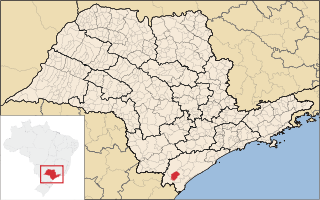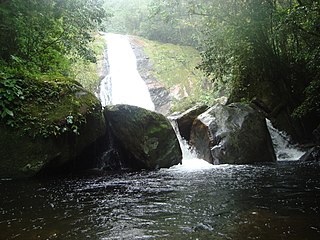
The Tijuca National Park is an urban national park in the mountains of the city of Rio de Janeiro, Brazil. The park is part of the Atlantic Forest Biosphere Preserve, and is administered by the Chico Mendes Institute for Biodiversity Conservation (ICMBio).

Cajati is a municipality in the state of São Paulo in Brazil. The population is 28,494 in an area of 454 km2. The elevation is 75 m.

Resende is a municipality in the Brazilian state of Rio de Janeiro. The population is 132,312 in an area of 1094 km2. Resendense refers to people or things that come from or inhabit Resende. It is the oldest town in this region, which has boundaries with the state of São Paulo and Minas Gerais. It is an important industrial, automotive, metallurgical, and tourist center, and headquarters of the world's second-largest military complex, the Academia Militar das Agulhas Negras (AMAN). Resende is of national importance and houses the Nuclear Fuel Factory complex of the "Indústrias Nucleares" of Brasil, the only one able to enrich uranium. Resende's automotive area holds MAN Latin America, the biggest truck and bus factory of Brazil, limited to PSA Peugeot Citroën and Michelin.

The Ilhas Cagarras are an uninhabited archipelago located 5 km off Ipanema, a major beach of the southern coast of the city of Rio de Janeiro, Brazil. They have been designated a federal natural monument since 2010.

Protected areas of Brazil included various classes of area according to the National System of Conservation Units (SNUC), a formal, unified system for federal, state and municipal parks created in 2000.

The Catimbau National Park is a national park in the state of Pernambuco, Brazil. It protects a semi-arid area of caatinga with sandstone caverns and caves in which prehistoric art has been found.

Saint-Hilaire/Lange National Park is a national park in Paraná, Brazil.

Cairuçu Environmental Protection Area is a protected area in the south of Rio de Janeiro state, Brazil. It contains an important remnant of the Atlantic Forest biome.
The Protected areas of Portugal are classified under a legal protection statute that allows for the adequate protection and maintenance of biodiversity, while providing services for ecosystem that maintains the natural and geological patrimony.

Guaratiba Biological and Archeological Reserve is a State biological reserve located in the western zone of Rio de Janeiro city, in the State of Rio de Janeiro, Brazil. It protects an important area of mangroves and wetlands in the east of Guaratiba Bay.

The Marapendi Natural Reserve is a coastal nature preserve of approximately 665.62 hectares, located in the Barra da Tijuca and Recreio neighborhoods of Rio de Janeiro, Brazil, established for the preservation of native plants and animals such as the Paraná and jacarandas pines, restinga, mangroves and the Channel-billed toucan.

A protected area mosaic or conservation unit mosaic in Brazil is a mosaic of nearby, adjoining or overlapping protected areas of Brazil that are managed as a whole.
The Rio Pombo Nature Park, formerly the Serrinha do Alambari Municipal Park, is a municipal nature park in the state of Rio de Janeiro, Brazil.

The Petrópolis Municipal Nature Park is a municipal nature park in the state of Rio de Janeiro, Brazil.
The Restinga Municipal Nature Park is a municipal nature park in the state of Paraná, Brazil. It was created to protect a strip of coastal vegetation, but little has been done to implement the park.

The Pau Oco State Park is a state park in the state of Paraná, Brazil. It protects an area of Atlantic Forest. The main attraction is the Salto da Fortuna, a waterfall.

The Lagamar de Cananéia State Park is a state park in the state of São Paulo, Brazil.

The Carioca Mosaic is a protected area mosaic in the state of Rio de Janeiro, Brazil. It includes various federal, state and municipal conservation units in and around the city of Rio de Janeiro.

The Sugarloaf Mountain and Urca Hill Natural Monument is a natural monument in the city of Rio de Janeiro, Brazil. It protects the Sugarloaf Mountain and the adjoining Morro da Urca, distinctive landmarks of the city.

The Mendanha State Park (Portuguese: Parque Estadual do Mendanha is a state park in the state of Rio de Janeiro, Brazil.

















